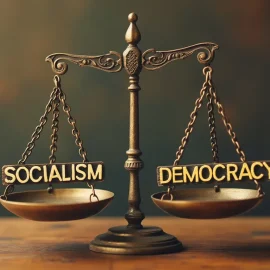

This article is an excerpt from the Shortform book guide to "Economics in One Lesson" by Henry Hazlitt. Shortform has the world's best summaries and analyses of books you should be reading.
Like this article? Sign up for a free trial here .
What is the purpose of price setting? How does artificial lowering or raising of prices for goods/services affect the economy?
Sometimes the government’s efforts to help businesses include raising or lowering the prices of goods. As with other government interventions, price setting throws off the balance of supply and demand and, thus, creates ill effects.
In this article, we’ll take a look at some of the most common price setting strategies and how they affect the economy.
What Is Price Setting?
When the private sector is struggling, the government may sometimes intervene by artificially raising or lowering the prices of goods and services. While this may help businesses get out of the slump, it can also destabilize the demand-supply equilibrium. Below, we’ll consider three different price-setting strategies and their effects on the economy.
1. Parity Pricing
Through exports and domestic sales, there is a steady demand for agricultural goods—but their prices and profits are not always as stable. During the Great Depression, the price of farm goods plummeted, but the cost of industrial goods and farm equipment decreased only slightly. As a result, farmers couldn’t make enough to buy industrial products, which shrunk the supply of farm goods, and limited supplies raised the cost of groceries. Meanwhile, many consumers had been laid off from their jobs and couldn’t afford higher-priced groceries and other farm products.
Parity pricing strategies were enacted in order to prevent this vicious cycle from repeating in the future. Parity pricing establishes a price for farm goods that is equal to the cost of the industrial goods that a farmer must buy to produce those goods. The principle behind parity pricing is that agriculture is the most basic and necessary industry in a nation, and that its prosperity benefits everyone, thus it must be protected. The fallacy behind parity pricing is that when farmers get higher prices for their goods, they’ll be able to buy more industrial goods, which will support full employment. However, as we’ll discuss next, parity pricing raises the cost of farm goods, so that the industrial workers whose jobs are supported by the farmers’ supplemented income consequently face a higher cost of living.
The Consequences of Parity Pricing
Parity pricing is yet another example of the government artificially altering the market. This is evident in the government’s various methods for raising the prices for farm goods, such as:
- Forcing the market to buy crops at a declared price
- Buying farm products at the parity price
- Lending farmers money that allows them to keep their goods off the market until the price of goods reaches the parity level
- Limiting how much farmers produce
No matter the method, parity pricing has several ill effects. First, two of the methods listed above raise prices by reducing supply in order to increase demand—the government mandates that farmers produce less, or the government pays the farmers to hold some goods off market to limit the supply that’s available to sell. Although the farmer gets more money per bushel (or barrel, or whatever the measurement of a particular crop), a smaller supply of farm goods makes the nation poorer overall—in other words, reducing national wealth. Additionally, although the parity pricing pads farmers’ profits, it also limits their production and sales. This means that farmers sell fewer goods at a higher price, and their income does not increase.
Second, the parity prices that enable farmers to earn an extra dollar per bushel of wheat also mean that bread bakers have to pay an extra dollar per bushel, and the price of bread rises proportionately. This has different effects for two types of supermarket shoppers:
- Shoppers who work in the farm-equipment industry are better able to manage the increased price of bread, because farmers’ increased profits led to more farm equipment sales, thus supporting those workers’ wages.
- Shoppers who don’t work in the farm-equipment industry suffer a net loss because their wages have been unaffected by parity pricing.
Parity Pricing Doesn’t Compensate for Tariffs
Some people argue that parity pricing helps farmers to compensate for the ways they’re hurt by protective tariffs. Protective tariffs decrease imports for the farm-equipment industry in order to support American-made products—but, when foreign countries export less to the U.S., they also have less money to buy American farm exports.
There are a few problems with the suggestion that parity pricing repairs the damage done by tariffs. First, while the farmer benefits from parity pricing, consumers lose twice because they face higher prices for goods because of tariffs as well as for groceries because of parity pricing.
Second, it’s impossible to protect or subsidize every industry equally. If one industry is protected with a tariff, then another industry that’s negatively impacted needs protection by a subsidy, which creates a ripple effect of other industries that would be positively and negatively affected. There are too many overlapping consequences to put everyone on equal footing. The only solution is to abolish both tariffs and parity pricing.
2. Commodity Price Setting
Fallacy: Government efforts to stabilize commodity prices protect the profits of producers, thus supporting employment and collective wealth.
Reality: Government efforts to stabilize commodity prices reward inefficient producers, create market instability, and reduce overall productivity and wealth.
While parity pricing applies to agriculture, the government artificially adjusts prices in other industries, as well. When the prices of goods drop, people worry that, in the time it takes supply and demand to organically adjust prices, producers will be driven out of business and employees will lose their jobs. These concerns lead to a call for the government to step in and stabilize commodity prices—but, as with parity pricing, this effort brings unintended consequences.
One effort to stabilize prices involves the government either buying crops off the farmers or paying them to keep some of their goods off the market, in order to raise prices by creating an artificial supply shortage. The concern behind this plan is that farmers will put their entire stock of crops on the market all at once—immediately after harvest—and that the surge of supply will make prices plunge and hurt farmers’ profits. However, this strategy has several negative consequences, including:
- Artificially raising prices means that consumers have less money to spend on other goods, which deprives other industries of that money to support wages and production.
- Consumers find other sources of the goods, and they don’t return to buy from the farmers in subsequent years.
- Foreign producers see an opening in the market and expand their own production, which creates increased competition.
- When this policy involves restricting production, it leads to fewer total goods, which equates to less collective wealth.
Sometimes the government simply sets a higher price for goods, without restricting production. This leads to:
- An ever-growing surplus of unsold goods, which causes prices to drop when those goods are finally released to the market
- A tendency for producers to expand their production to take advantage of the artificially high prices, which contributes to the unsold surplus
Both of these outcomes cause prices to eventually collapse, which creates far more instability in market prices (ironically out of an effort to stabilize prices) than would have resulted from relying on supply and demand.
Proponents of efforts to stabilize commodity prices believe that the speculators who buy large stocks of crops get the profits that farmers should be getting, because the speculators buy from the farmers when the prices are low, and then reap the benefits of higher prices when they resell the crops later. But in reality, the speculators act as a buffer between the farmers and the market. Since the speculators continue to sell the goods throughout the year, they provide a consistent supply to the market, which stabilizes prices for that window of time when farmers sell their goods.
Of course, prices occasionally drop as a natural result of supply and demand, and some producers are naturally driven out of business—but they are the most inefficient producers in an industry. When inefficient producers shut down, it creates space for the most efficient producers to expand, and those producers are able to offer their goods at a lower price. As a result, consumers have access to an adequate supply of goods at a low price, which leaves them more money to spend on other things, thus supporting other industries and increasing national productivity and wealth.
3. Price Ceilings
Fallacy: Artificial price ceilings on goods help consumers by preventing the cost of living from rising.
Reality: Artificial price ceilings create shortages of goods, which cause the government to impose other remedies, which each create additional negative ripple effects.
The ill effects of price-fixing aren’t limited to when the government artificially raises prices, but also when it artificially lowers prices. During wartime and other circumstances when inflation causes prices to balloon, the government attempts to help consumers by putting a ceiling on the price of goods—particularly essential goods, such as food. As with other policies that involve the government’s interference with the free market, the intentions may be good, but the consequences are harmful and far-reaching.
When the government keeps prices below what supply and demand would dictate, it produces several outcomes:
- Demand increases, because people can afford to buy more of the good.
- Supply decreases, because people buy larger amounts of the good.
- Production decreases, because producers’ profits are limited by the fixed prices of their goods. This effect puts inefficient producers out of business and forces efficient producers to operate at a loss. Additionally, since price ceilings are usually applied to essential goods, producers are disincentivized from producing essential goods, and they are lured toward producing luxury goods, because those prices and profits are not restricted.
As a result, the government’s attempt to make essential goods more universally accessible to consumers actually leads to a supply shortage.
Attempts to Remedy Shortages Caused by Price Ceilings
When this effect takes hold, the government may try to regain balance by imposing some combination of the following:
- Rationing: When commodities are in short supply, rations limit how much of the commodity each consumer can buy, so that some consumers can’t buy large quantities and leave nothing for others. Rationing imposes a dual currency system, which requires people to buy the commodity with a combination of money and allotted points. The effect simulates the way higher prices reduce the demand for goods through the price system—but, unlike the price system, rationing fails to stimulate supply, as would be the case if producers were getting higher prices for their goods.
- Cost controls: Since rations limit producers’ profits, the government may impose cost controls to limit the cost of production. If the rationed commodity is beef, then cost controls would fix the cost of cattle feed, the wages of farmhands, the cost of live cattle, the slaughterhouse costs, and the wholesale cost of beef. However, fixing the prices of all these aspects of production has the same effect as pushing down the cost of beef: The price-fixing creates shortages of labor, cattle feed, and every other aspect that has been cost-controlled.
- Subsidies: In order to remedy the low profits and low wages that result from price ceilings, the government may offer subsidies to commodity producers. The subsidies enable producers to earn as much as they would have on the free market—meanwhile, consumers enjoy lower prices for their goods. However, the consumers who get to buy their beef for a dollar less per pound are also paying taxes to fund the subsidy that’s supporting that price ceiling.
When price ceilings create chronic shortages of a commodity, consumers find substitute goods to meet their needs. As the demand grows for these substitute goods, their prices rise and their supplies drop, which can cause the government to impose price ceilings and rations, creating a ripple effect. This cascade of commodity shortages creates space for budding black markets, which can potentially grow to surpass the legal price-ceiling market. However, producers in the black market tend to produce less efficiently, sell poorer-quality goods, and charge more than established legal producers would under normal circumstances.
3. Rent Control
Fallacy: Rent control protects tenants from skyrocketing housing prices.
Reality: Rent control hurts tenants by discouraging building maintenance as well as construction of new affordable housing.
Another form of price-fixing is rent control, which is often viewed as a method to support low- and middle-income tenants. However, in the long run, rent control hurts not only low- and middle-income tenants, but also landlords, communities, and cities:
- Rent control encourages a wasteful use of space, because tenants become reluctant to leave their apartments, even if their families have shrunk as children have grown up and moved out. Since rent control is meant to combat rising housing prices, and those climbing prices likely reflect a high demand for housing, tenants who stay in rent-controlled apartments that are bigger than they need are using the space inefficiently. By contrast, if rents were determined by free-market prices, tenants would be forced to rent spaces that fit their needs, which would leave more space available to those who need it.
- Rent control discourages new housing construction, because landlords’ and builders’ profits are so limited that there is either no incentive to invest in building new housing, or they simply have no money to do so. Additionally, landlords and builders may worry that, if they do build new housing, the government will later impose rent control on it.
- Rent control discourages construction of affordable housing when the policy applies only to affordable housing and exempts luxury housing. Although the intention is to help low-income renters by providing the price cut, the result actually further hurts them. Builders are incentivized to build luxury housing—where they can earn profits by charging market-rate rent—and deterred from constructing affordable housing, which increases the supply shortage.
- Rent control discourages maintenance and remodeling in affected buildings, because the lower rents may cut into landlords’ profits so much that they can’t afford to make necessary improvements. As a result, tension rises between the landlord who is forced to operate with little or no profit and tenants who resent the landlord’s negligence. The landlord may eventually be unable to provide basic services, such as heat and hot water, which can force tenants to abandon the building. Abandoned buildings are often overtaken by squatters and vandals, and the rent-controlled building becomes a blight on the neighborhood.
- Rent control lowers the property-value base, which decreases city revenues from taxes. This can hurt city finances to the point that it can no longer provide basic services, or that it ultimately has to declare bankruptcy.
When rent control slows or stops construction of affordable housing, the government may attempt to remedy the problem by building housing with tax dollars, which hurts taxpayers in multiple ways:
- The taxes used to build the housing reduce taxpayers’ purchasing power, which indirectly hurts other industries.
- The rents charged for this housing are so low that they don’t cover the cost of the building’s construction and operation, so the government often pays subsidies to tenants or to builders or building managers. These subsidies essentially force taxpayers to help pay the rents of a small group of people.
The more extreme the rent-controlled price is, the more damage it does, and the harder it is to abolish. In other words, if the policy keeps rents at 50 percent of the market rate, the price cut decreases landlords’ profits and disincentivizes new construction more than a policy that held rents just 5 percent below the market rate. Additionally, if the government tried to get rid of rent control, there’d be greater outcry from tenants whose rents would double than from tenants who would face a much smaller rent increase.

———End of Preview———
Like what you just read? Read the rest of the world's best book summary and analysis of Henry Hazlitt's "Economics in One Lesson" at Shortform .
Here's what you'll find in our full Economics in One Lesson summary :
- A clear, concise explanation of the secondary consequences of a range of economic policies
- How labor-saving technology actually creates more jobs
- How saving money supports the economy more than spending it






